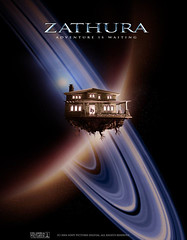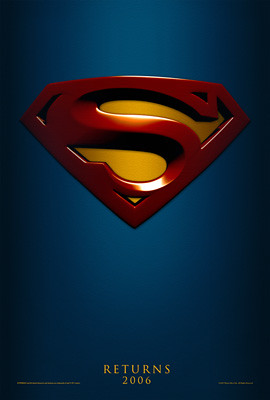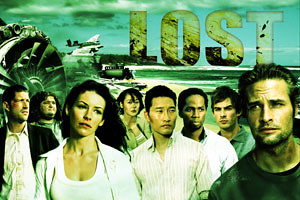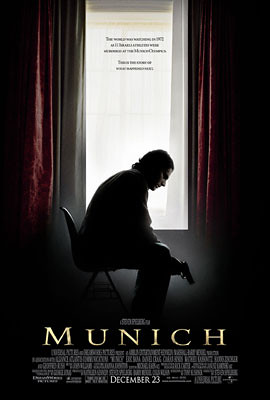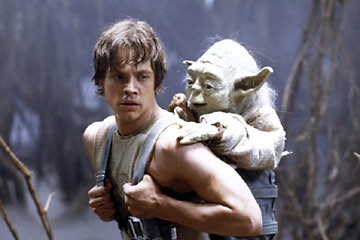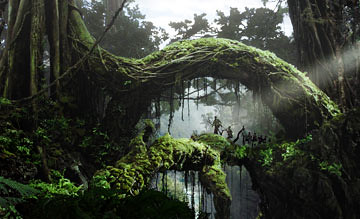Sometimes I want to smack myself in the head every time I get my hopes up for a movie. It seems that the lower my expectations are for a film, the more I’ll enjoy it.
Example: Jarhead, zero expectations. Result? Actually enjoyed myself.
Zathura: Fairly excited to see. Result? Discontent & disappointment.
Now, maybe I was a fool to think that this movie had a chance in heck of being good to begin with. It is after all, a bizarre conceptual sequel to the 1995 Jumanji, with an unpredictable director (Jon Favreau) and for the most part, starred unknowns. I loved Jumanji. I didn’t see it in theatres, but I remember having my wisdom teeth out when I was about sixteen and watching it on VHS over and over again. It just had this wonderfully magical feel to it, and I felt that I was transported to a strange house constantly morphing more and more into a jungle, right along with the children in the film. Though fantastical in its notion, the story had a logical throughline that could be followed, and both the kids and the adult Alan Parrish, each had their own different emotional stakes that were to be vindicated in the course of the movie. The writers of Jumanji were also aware, that no matter how much the house changed and altered its state, it would be folly to have the entire film take place in the confines of that house, and so both in the beginning and in the end, they took the adventure into the outside world.
Zathura on the other hand had none of these things. There was a deadening singularity of theme and purpose in the film, and the entire story took place in that one house. Sure the house itself was moving around the blackness of space, but there wasn’t enough diversity of images to create a true sense of travel in the film.
Danny and Walter are two brothers who just can’t get along. Walter is a ten year old in fourth grade who loves Sports Center and Brett Favre. Danny is a tentative six year old, trying to break out of the “baby” role, who unintentionally antagonizes his brother and father, played by a weary Tim Robbins. Walter is good at sports, but bad at waiting his turn. Danny has no physical coordination, but has a knack for things that require an imagination. They both drive ‘Dad’ nuts with their squabbling on a Saturday afternoon, when he has to focus on an impromptu conference call for work. You can guess the rest from here. Dad has to run out of the house unexpectedly, and he leaves Walter and Danny to their own devices. They start fighting, and Danny is chased into the basement where he discovers a dusty old board game ‘Zathura: a space adventure”. No sooner do they start to play it, then they suddenly become transported into outer space where they must survive meteor showers, killer robots, and carnivorous aliens.
Both the script and the direction were clearly homages to an 80’s Spielberg sci-fi extravaganza, but unfortunately, try as they might, the filmmakers could not capture an iota of the magic that courses through the veins of Spielberg’s films. Everything felt so fake and forced. The starry midnight blue sky peeking through the windows in every scene felt like cheap drapery hung over the set. The relationship between the brothers was so unsubtle and underdeveloped. The first fifteen or so minutes of the film felt so mechanical, and “thesis” oriented: “Ok, now see, the brothers don’t get along…but by the end of the film, they WILL. Won’t that be nice?” Part of the problem was that the characters of the two boys felt so stock, so blah, so typical that there wasn’t any inherent source of conflict, (i.e., one was a piano virtuouso, the other a football star ---trite as that might be at least that would have been something), they were just two little boys who didn’t get along, due strongly in part to their age difference. To add to this yawn inducing family dynamic was an older sister, Lisa (played by Kristen Stewart, Jodi’s daughter in Panic Room). Lisa, who is asleep for the first third of the film, and cryogenically frozen for the second third, is a high schooler who couldn’t be less interested in her brothers or the games they might be playing. Her one M.O. is to get ready for her date that night, which she is terrified she might be late for. She doesn’t even realize that her family’s house is cavorting through outer space until about an hour into the movie. (More nonsense).
Then there’s the astronaut, (played by an amiable Dax Shepard) a spry guy, somewhere in his 20’s, who appears outside their house, summoned thither by the board game. While Walt and Danny are weary of him at first, they quickly realize that he will come in handy, with his knowledge of Zorgons (evil aliens) and his ability to protect them through the rest of the game. Lisa quickly becomes smitten with him and has no qualms about his presence either.
When Walt’s gets an elusive gold card during his turn, it tells him that a shooting star is about to pass by, and he should make a wish. The astronaut, who has witnessed first hand, the bad blood between Walt and his younger brother Danny, is terrified that Walt is going to wish Danny away. After Walt makes his wish, and we see he only wished for an autographed football, the astronaut confesses his fear to Walt. He admits that he too was once a player of Zathura when he was a young boy, and that like Walt, he played it with his little brother. Angry at his brother, for ‘messing things up,’ the astronaut wished that his brother had never been born. Sure enough, his brother vanished, but the astronaut was stuck in the game for eternity; there was no longer anyone to play through the rest of the game with him so that he could return home.
As if this wasn’t cheesy enough, about thirty minutes later, Walt pulls another shooting star card from the game, and what does he wish for? He wishes that the astronaut could get his brother back. White fuzzy light starts to swirl around the room and surround the astronaut, but what’s this? Where the astronaut’s brother should reappear, is another little boy who looks just like Danny. And as Walt looks about in confusion, we see the astronaut reverse age and become….Walt. The astronaut is Walt….or what would have happened to Walt if he had gone ahead and wished Danny out of existence. But try and follow the logic, --I dare you. If Walter is living in the present, playing the game with Danny in the here and now, how the hell is he also grown up and floating around in space, trapped in eternity for a poor decision he never made. Am I to believe they somehow intersected with a parallel universe while playing the game? It makes absolutely no sense, and it reminds me of the plot nonsense that went on in The Fog, where they attempted to justify a character as a person, as a ghost, etc. It is a methodology that I hereby proclaim as a ‘Fogism.’
Like a typical Fogism, there was little foreshadowing or allusion to the fact that the astronaut was actually Walt. No emotion laden moments were shared between them, no tip offs to the fact that they were the same person. It came out of nowhere, and it felt forced and artificial.
So Walt rights the wrong he never wronged. The astronaut is released from captivity (or rather Walt is). The whole family gets back to earth again, their house is restored to its original state and it’s as if nothing ever happened to begin with.
So what was the point of all of this? Is the final redemption simply that Walter and Danny are now as thick as thieves? That Walter now gets to tease Lisa for thinking that his older alter ego has pretty eyes? This movie was boring. It was unexciting, and unengaging. I think it certainly had potential to be more than it was, but the striking imagery of the uprooted house floating through space, and a clever concept was not enough to yank it out of the doldrums of pedestrian mediocrity. I was even willing to concede about half way through the film, that it was perhaps, just a kids’ film, and was supposed to be silly, goofy, fun. Maybe I’d have been more enthralled by it if I was sixteen years younger. But then I realized this wasn’t so, this genre was right up my alley. No, it wasn’t just its simplicity that aggravated me, it was its lack of embellishment and originality.
Thank God for Harry Potter. Goblet of Fire, here I come!
